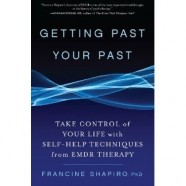
This post is to recommend a new, self-help book by EMDR (Eye Movement Desensitization and Reprocessing) developer Francine Shapiro, Ph.D, Getting Past Your Past; Take Control of Your Life with Self-Help Techniques from EMDR Therapy (2012). For more information about EMDR, see this website’s “Services” link.
Early in chapter one, Shapiro offers a simple experiment which not only sets the tone for the book, but EMDR in general. Asking for the first thing that pops into the reader’s mind, she writes: “Roses are red…” There’s an extremely high probability that you will answer: “Violets are blue.” That is, for most people, “violets are blue” is the familiar and oft-quoted response to: “Roses are red.” It’s Shapiro’s rhetorical way of emphasizing the “automaticity” of the human brain; similar to the body’s reaction to a doctor’s tap on our knee. “Automaticity” is often a wonderful human quality (not having to relearn the same thing(s) all the time), but it sometimes has a dark side too; for example, mindlessly reacting to harmless situational “triggers.” Shapiro writes:
“Every experience we’ve had in our lives has become a building block in our inner world, governing our reactions to everything and every person we encounter. When we ‘learn’ something, the experience is physically stored within networks of brain cells (neurons). These networks actually form our unconscious mind, determining how our brain interprets the world around us and governing how we feel from moment to moment. These memories include experiences that took place years ago, and our conscious mind is often unaware that they have any impact on us at all. (Consequently), the memories…can pop up outside our control (like) ‘Roses are red…” (pp. 3-4).
Getting Past Your Past (2012) not only informs the reader how these and other issues can be addressed in counseling, but offers many self-help strategies that one can use outside counseling. Here’s one example.
Identify something that has bothered you recently. On a sheet of paper labelled “Touchstone List” (“Touchstone” referring to an earlier, unprocessed memory), draw a line down the middle of the page. Label the left column “Recent Events.” Label the right column “Memories.” Under the “Recent Events” column, briefly describe what happened, along with any negative thoughts (about yourself), feelings, and/or physical sensations. Then, let your mind float back to an earlier time when you may have thought and/or felt similarly. Write down that memory opposite the recent event. You could be noticing your first clue as to why the recent event bothered you so much. The two experiences are linked via an unprocessed experience (pp. 77-78).
Because such an exercise carries with it potential distress for some people, it’s important to use the self-calming techniques that Shapiro’s describes. But, you’ll have to read the book to learn about those. 🙂

